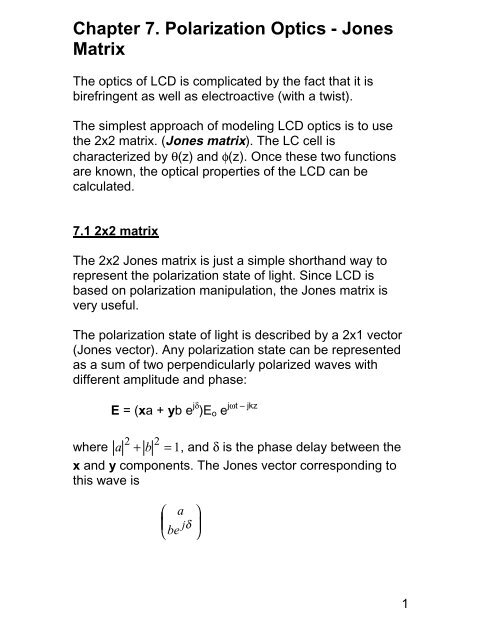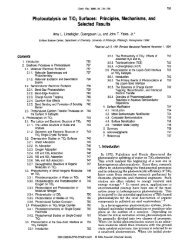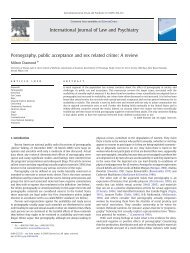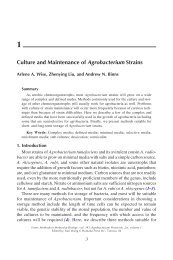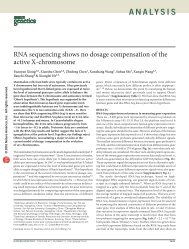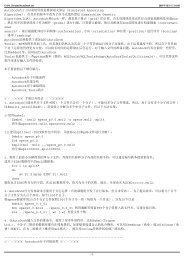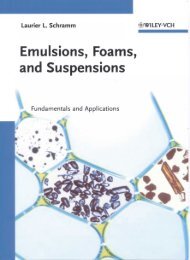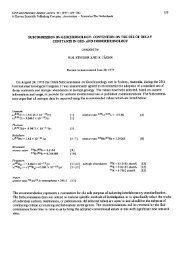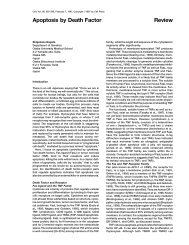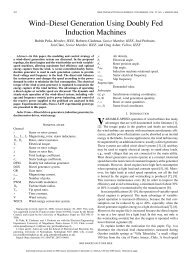Chapter 7. Polarization Optics - Jones Matrix
Chapter 7. Polarization Optics - Jones Matrix
Chapter 7. Polarization Optics - Jones Matrix
Create successful ePaper yourself
Turn your PDF publications into a flip-book with our unique Google optimized e-Paper software.
<strong>Chapter</strong> <strong>7.</strong> <strong>Polarization</strong> <strong>Optics</strong> - <strong>Jones</strong><br />
<strong>Matrix</strong><br />
The optics of LCD is complicated by the fact that it is<br />
birefringent as well as electroactive (with a twist).<br />
The simplest approach of modeling LCD optics is to use<br />
the 2x2 matrix. (<strong>Jones</strong> matrix). The LC cell is<br />
characterized by θ(z) and φ(z). Once these two functions<br />
are known, the optical properties of the LCD can be<br />
calculated.<br />
<strong>7.</strong>1 2x2 matrix<br />
The 2x2 <strong>Jones</strong> matrix is just a simple shorthand way to<br />
represent the polarization state of light. Since LCD is<br />
based on polarization manipulation, the <strong>Jones</strong> matrix is<br />
very useful.<br />
The polarization state of light is described by a 2x1 vector<br />
(<strong>Jones</strong> vector). Any polarization state can be represented<br />
as a sum of two perpendicularly polarized waves with<br />
different amplitude and phase:<br />
E = (xa + yb e jδ jωt – jkz<br />
)Eo e<br />
2 2<br />
where a + b = 1,<br />
and δ is the phase delay between the<br />
x and y components. The <strong>Jones</strong> vector corresponding to<br />
this wave is<br />
⎛ a<br />
⎞<br />
⎜ jδ<br />
⎟<br />
⎝be<br />
⎠<br />
1
Notice that any common phase in a and b can be taken<br />
out and be absorbed by the phase term e jωt-jkz. .<br />
Examples of <strong>Jones</strong> vectors:<br />
⎛cosα<br />
⎞<br />
⎜ ⎟<br />
⎝ sinα<br />
⎠<br />
1 ⎛1<br />
⎞<br />
⎜ ⎟<br />
2 ⎝ j ⎠<br />
refers to light polarized at angle α to the x-axis.<br />
represents a right-circularly polarized light<br />
In the <strong>Jones</strong> vector and <strong>Jones</strong> matrix approach, every<br />
optical element is represented by a 2x2 matrix.<br />
Jin<br />
M<br />
Then Jout = M Jin<br />
Jout<br />
A few examples of <strong>Jones</strong> matrices:<br />
⎛1<br />
0⎞<br />
x-axis polarizer Mx = ⎜ ⎟<br />
⎝0<br />
0⎠<br />
2
Retardation plate with y-axis as the fast axis:<br />
Mδ =<br />
1 ⎛ δ<br />
⎜e<br />
j<br />
2 ⎜<br />
⎝ 0<br />
<strong>Polarization</strong> rotator:<br />
0 ⎞<br />
⎟<br />
− δ<br />
e<br />
j ⎟<br />
⎠<br />
⎛cosθ − sinθ<br />
⎞<br />
MR(θ) = ⎜<br />
⎟<br />
⎝ sinθ<br />
cosθ<br />
⎠<br />
Can easily show that a linearly polarized light polarized at<br />
α to the x-axis becomes α+θ to the x-axis after passing<br />
through M3.<br />
⎛cos(<br />
α + θ ) ⎞<br />
⎜ ⎟ =<br />
⎝ sin( α + θ ⎠<br />
⎛cosα<br />
⎞<br />
M R(<br />
θ ) ⎜ ⎟<br />
⎝ sinα<br />
⎠<br />
The <strong>Jones</strong> matrix is very useful in problems concerning<br />
polarization manipulation, such as the LCD. If there are<br />
more than one polarization manipulation element, we<br />
simply multiply the <strong>Jones</strong> matrices:<br />
Jin<br />
M1 M2 M3 MN<br />
Jout<br />
3
and φ is the rotation angle from (x,y) to (x’,y’) as shown in<br />
the diagram.<br />
Note that Rφ = ΜR −1 (φ) = ΜR(-φ)<br />
Also R-φ = Rφ −1 = Rφ ’<br />
Proof:<br />
⎛ x ⎞ −1⎛<br />
x'⎞<br />
⎛ x'⎞<br />
It is easy to show that ⎜ ⎟ = Rφ<br />
⎜ ⎟ = M R( φ)<br />
⎜ ⎟<br />
⎝ y⎠<br />
⎝ y'⎠<br />
⎝ y'⎠<br />
Also, any vector J in (x, y) system is related to J’ in (x’, y’)<br />
system by a rotation<br />
J = R-φ J’<br />
or J’ = Rφ J<br />
Hence, if K = M J<br />
then K’ = Rφ K = Rφ M J = Rφ M R-φ Rφ J<br />
or K’ = M’ J’<br />
where M’ = Rφ M R-φ<br />
Also the reverse transformation is given by<br />
M = Rφ −1 M’ Rφ<br />
5
For example, rotate x axis by +90 o ,<br />
R90<br />
⎛ 0<br />
= ⎜<br />
⎝−<br />
1<br />
1⎞<br />
⎟<br />
0⎠<br />
A retardation plate with x-axis as fast axis will have a<br />
<strong>Jones</strong> matrix of<br />
⎛ 0<br />
⎜<br />
⎝−<br />
1<br />
1⎞⎛<br />
jδ<br />
⎟⎜e<br />
0⎠<br />
⎜<br />
⎝ 0<br />
⎞⎛<br />
− ⎞ ⎛ − jδ<br />
0 0 1<br />
⎞<br />
⎟⎜<br />
⎟ = ⎜e<br />
0 ⎟<br />
− jδ<br />
⎟<br />
⎝ ⎠<br />
⎜ jδ<br />
e<br />
⎟<br />
⎠ 1 0 ⎝ 0 e ⎠<br />
The <strong>Jones</strong> matrix of a retardation plate with the fast axis at<br />
φ to the x-axis is given by<br />
⎛ − jδ<br />
−<br />
⎜e<br />
R φ ⎜<br />
⎝ 0<br />
⎞ ⎛cosφ − sinφ<br />
⎞⎛<br />
− jδ<br />
0 ⎟ = ⎜<br />
⎟⎜e<br />
R<br />
jδ<br />
⎟ φ<br />
e ⎝<br />
⎠<br />
⎜<br />
⎠ sinφ<br />
cosφ<br />
⎝ 0<br />
0 ⎞⎛<br />
cosφ<br />
⎟⎜<br />
jδ<br />
e<br />
⎟<br />
⎠⎝−<br />
sinφ<br />
Note that we are transforming from (x’,y’) to (x,y) in this<br />
case. The (x’,y’) frame is the principle axes of the<br />
retardation plate and the (x,y) axes are the fixed<br />
laboratory frame.<br />
This formula is very important. We shall see later that the<br />
LC cell can be regarded as a stack of birefringent plates.<br />
Some more manipulations of <strong>Jones</strong> matrices:<br />
1. Half wave plate:<br />
The Jone matrix of a half wave plate with c-axis on the xaxis<br />
is<br />
⎛− j<br />
⎜<br />
⎝ 0<br />
0⎞<br />
⎟<br />
j ⎠<br />
sinφ<br />
⎞<br />
⎟<br />
cosφ<br />
⎠<br />
6
Then Jout = MN …M3 M2 M1 Jin<br />
<strong>7.</strong>2 Coordinate transformation<br />
The <strong>Jones</strong> matrix depends on the definition of the<br />
coordinate system. If the coordinate is rotated by φ, the<br />
<strong>Jones</strong> matrix will become different.<br />
y’<br />
y<br />
φ<br />
P<br />
Rule: If the <strong>Jones</strong> matrix is M in the (x,y) coordinates and<br />
M’ in the (x’,y’) coordinate system, then<br />
M’ = Rφ M Rφ −1<br />
and M = Rφ −1 M’ Rφ<br />
where Rφ is the coordinate transformation matrix<br />
Rφ<br />
=<br />
⎛ cosφ<br />
⎜<br />
⎝−<br />
sinφ<br />
sinφ<br />
⎞<br />
⎟<br />
cosφ<br />
⎠<br />
x’<br />
x<br />
4
The <strong>Jones</strong> matrix of a half wave plate with c-axis at θ to<br />
the x-axis is<br />
⎛cosφ − sinφ<br />
⎞⎛−<br />
j<br />
⎜ ⎟⎜ ⎝ sinφ<br />
cosφ<br />
⎠⎝<br />
0<br />
Check:<br />
⎛cos2φ<br />
⎜<br />
⎝ sin 2φ<br />
0 ⎞⎛<br />
cosφ<br />
⎟⎜ j ⎠⎝−<br />
sinφ<br />
sinφ<br />
⎞ ⎛cos2φ<br />
⎟ = ⎜<br />
cosφ<br />
⎠ ⎝ sin 2φ<br />
sin 2φ<br />
⎞⎛1<br />
⎞ ⎛cos2φ<br />
⎞<br />
⎟⎜ ⎟ = ⎜ ⎟<br />
− cos2φ<br />
⎠⎝0<br />
⎠ ⎝ sin 2φ<br />
⎠<br />
sin 2φ<br />
⎞<br />
⎟<br />
− cos2φ<br />
⎠<br />
which is equivalent to a rotation of the linear polarization<br />
along x by 2φ. This <strong>Jones</strong> matrix is not the same as the<br />
polarization rotation matrix since the rotation is dependent<br />
on the polarizer angle.<br />
2. Quarterwave plate<br />
The <strong>Jones</strong> matrix of a quarterwave plate with c-axis along<br />
the x-axis<br />
M<br />
=<br />
1 ⎛1−<br />
j<br />
⎜<br />
2 ⎝ 0<br />
0 ⎞<br />
⎟<br />
1+<br />
j ⎠<br />
If light polarized at 45 o to the x-axis passes through it, the<br />
new <strong>Jones</strong> vector is<br />
1 ⎛1−<br />
j<br />
J = ⎜<br />
2 ⎝ 0<br />
0 ⎞⎛1⎞<br />
1 ⎛1−<br />
j ⎞ 1−<br />
j ⎛1<br />
⎞<br />
⎟⎜ ⎟ = ⎜ ⎟ = ⎜ ⎟<br />
1+<br />
j ⎠⎝1⎠<br />
2 ⎝1+<br />
j ⎠ 2 ⎝ j ⎠<br />
which is a right circularly polarized wave.<br />
3. Polarizer<br />
7
The <strong>Jones</strong> matrix of a polarizer with polarizing axis along x<br />
⎛1<br />
0⎞<br />
is ⎜ ⎟. So the <strong>Jones</strong> matrix of a polarizer with the<br />
⎝0<br />
0⎠<br />
polarizing axis at θ is given by<br />
⎛ cos φ − sin φ ⎞⎛<br />
1<br />
⎜<br />
⎟⎜<br />
⎝ sin φ cos φ ⎠⎝<br />
0<br />
⎛ 2<br />
= ⎜ cos φ<br />
⎜<br />
⎝sinφ<br />
cosφ<br />
sinφ<br />
cosφ<br />
⎞<br />
⎟<br />
2<br />
sin φ<br />
⎟<br />
⎠<br />
0 ⎞⎛<br />
cos φ<br />
⎟⎜<br />
0 ⎠⎝<br />
− sin φ<br />
sin φ ⎞<br />
⎟<br />
cos φ ⎠<br />
4. Eigenvalues and eigenvectors of the <strong>Jones</strong> matrix<br />
Any matrix can be diagonalized to find the eigenvalues<br />
and eigenvectors. For the 2x2 <strong>Jones</strong> matrix, the 2<br />
eigenvectors correspond to the <strong>Jones</strong> vector that can<br />
propagate through the system without any change of<br />
polarization state.<br />
M J = λ J<br />
Exercise: Find the eigenvectors of the retardation plate<br />
and the polarizer <strong>Jones</strong> matrices.<br />
<strong>7.</strong>3 LCD <strong>Optics</strong> Modeling<br />
In the most common model, the LC cell is thought of as<br />
composed of N retardation plates. N is sufficiently large so<br />
that each slice can be regarded as having constant θ and<br />
φ, i.e. constant c-axis orientation. For twist angle smaller<br />
than 180 0 , N
20 for accuracy. This is the approach used in all<br />
commercial LCD modeling software.<br />
The LC cell then has a <strong>Jones</strong> matrix given by<br />
MLC = MN ….M3 M2 M1<br />
where Mn is the <strong>Jones</strong> matrix of a birefringent plate with caxis<br />
at angle φn to the x-axis and at θn to the z-axis.<br />
<strong>Jones</strong> matrix Mn<br />
y<br />
x<br />
φn<br />
n<br />
θn z<br />
If the fast axis is at angle φn to the x-axis, then the <strong>Jones</strong><br />
matrix is given by a coordinate transformation:<br />
Mn = Rφn –1 M’ Rφn<br />
where Rφn is the transformation matrix<br />
9
R<br />
φn<br />
⎡ cosφn<br />
= ⎢<br />
⎣−<br />
sin φ<br />
n<br />
sin φ<br />
cosφ<br />
<strong>Jones</strong> matrix of the general birefringent plate with c-axis<br />
along the principle axis (x’) is given by<br />
where<br />
with<br />
M’ =<br />
⎛ − δ<br />
⎜e<br />
j<br />
⎜<br />
⎝ 0<br />
0 ⎞<br />
⎟<br />
δ<br />
e<br />
j ⎟<br />
⎠<br />
πd(<br />
n ( θ ) )<br />
δ e − n<br />
=<br />
o<br />
λ<br />
n<br />
1<br />
=<br />
( θ )<br />
2<br />
e<br />
cos<br />
n<br />
2<br />
2<br />
o<br />
θ<br />
+<br />
sin<br />
The above formulas can be used for the modeling of LCD<br />
with arbitrary φ(z) and θ(z) distribution numerically. In<br />
particular, we shall work out a simple case of φ(z) and θ(z)<br />
below.<br />
<strong>7.</strong>4 <strong>Jones</strong> matrix of twisted nematic cells with uniform<br />
tilt<br />
The <strong>Jones</strong> matrix of a T-cell without any voltage applied<br />
can be obtained analytically.<br />
Assuming no pretilt for simplicity, θ(z) = 0. If there is a<br />
uniform tilt, then we can simply reduce Δn for all the<br />
birefringent plates.<br />
n<br />
2<br />
n<br />
2<br />
e<br />
n<br />
θ<br />
⎤<br />
⎥<br />
⎦<br />
10
The twist angle is given by<br />
φ(z) = qz = Φ z/d<br />
where Φ is the total twist angle of the LC cell. All twist<br />
angles are measured relative to the x-axis. The above<br />
equation already assumes that φ(0) = 0, i.e. the input<br />
director is parallel to the x-axis.<br />
Assuming N plates, then there are N <strong>Jones</strong> matrices. The<br />
twist angle of the nth plate is<br />
φn = n Δφ<br />
where Δφ = Φ / Ν<br />
Δφ 2Δφ<br />
NΔφ<br />
Therefore the LC <strong>Jones</strong> matrix is given by<br />
where<br />
MLC = (RNΔφ −1 M’RNΔφ)….(R2Δφ −1 M’R2Δφ)(RΔφ -1 M’RΔφ)<br />
⎛ − jδ<br />
/ N<br />
= ⎜e<br />
M '<br />
⎜<br />
⎝ 0<br />
y<br />
0 ⎞<br />
⎟<br />
jδ<br />
/ N<br />
e<br />
⎟<br />
⎠<br />
x<br />
z<br />
11
πdΔn<br />
with δ = = dΔk<br />
λ<br />
k k<br />
where Δk = e − o<br />
2<br />
πΔn =<br />
λ<br />
Now RnΔφR(n-1)Δφ −1 = RΔφ<br />
So MLC = RΦ −1 (M’RΔφ) N<br />
We can now make use of the Chebychev identity to<br />
simplify this matrix further. It can be shown that<br />
where<br />
⎛ A<br />
⎜<br />
⎝C<br />
N<br />
B ⎞<br />
⎟<br />
D⎠<br />
=<br />
⎛<br />
⎜<br />
⎝<br />
U N<br />
AU N −U<br />
N −1<br />
CU N<br />
sin NΩ<br />
=<br />
sin Ω<br />
and cos Ω = ½ (A + D)<br />
BU N ⎞<br />
⎟<br />
DU N −U<br />
N −1<br />
⎠<br />
This is valid for any unitary matrix with AD – BC = 1.<br />
(Exercise: Prove the Chebychev identity by induction)<br />
Then it is straight-forward to show that as N -> infinity,<br />
12
(M’RΔφ) N ⎛ Δk<br />
⎜cos<br />
βd<br />
− i sin βd<br />
= ⎜ β<br />
⎜ Φ<br />
⎜ − sin βd<br />
⎝ βd<br />
where β 2 d 2 = Φ 2 + Δk 2 d 2<br />
Finally, MLC can be written as a simple matrix<br />
MLC =<br />
⎛a−ib<br />
⎜<br />
⎝c−id<br />
−c−id⎞<br />
a+<br />
ib ⎠<br />
Φ ⎞<br />
sin βd<br />
⎟<br />
βd<br />
⎟<br />
Δk<br />
⎟<br />
cos βd<br />
+ i sin βd<br />
β<br />
⎟<br />
⎠<br />
Φ<br />
where a = cos Φ cos βd + sin Φ sin βd<br />
βd<br />
Δk b = cos Φ sin βd<br />
β<br />
Φ<br />
c = sin Φ cos βd - cos Φ sin βd<br />
βd<br />
Δ k<br />
d = sin Φ sin βd<br />
β<br />
This is an extremely useful result.<br />
Properties:<br />
(1) MLC is normalized, i.e. M LC = 1.<br />
(Check it.)<br />
13
(2) MLC is unitary. i.e. MLC *T = MLC -1 . (Check it). Recall<br />
from matrix algebra: the eigenvalues of unitary<br />
matrices have forms e jα (or unit length).<br />
(3) MLC changes if we change the twist sense, i.e.<br />
Φ → −Φ. The off-diagonal elements changes sign. But<br />
the properties remains the same. (e.g. the eigenvalues<br />
and eigenvectors are the same.) Therefore it does not<br />
matter how we define the twist sense, as long as it is<br />
consistent.<br />
(4) If the wave propagates in the opposite direction, i.e. we<br />
have a left-handed coordinate system, then MLC<br />
becomes MLC*. Proof: if z → -z, then M’ → Μ’*. This is<br />
a useful result for reflective displays.<br />
(5) It can be shown that<br />
MLC = Rφ −1 Τ −1<br />
⎛ −iβd<br />
⎜e<br />
⎜<br />
⎝ 0<br />
0 ⎞<br />
⎟ Τ<br />
iβd<br />
e<br />
⎟<br />
⎠<br />
⎛ cos χ − i sin χ ⎞<br />
where T = ⎜ ⎟ and sin 2χ = φ/βd.<br />
⎝−<br />
i sin χ cos χ ⎠<br />
In this form, the LC cell behaves as a “rotating<br />
waveplate”.<br />
<strong>7.</strong>5 Eigenvalues and eigenvectors of MLC<br />
The eigenvalues of the LC <strong>Jones</strong> matrix can be obtained<br />
indirectly. Let us first find the eigenvectors of (MRΔφ) N .<br />
Recall that MLC = RΦ −1 (M’RΔφ) N<br />
Write (M’RΔφ) N ⎛ g *<br />
h ⎞<br />
= ⎜ ⎟<br />
⎝−<br />
h g ⎠<br />
14
Δk<br />
where g = cos βd + i sin βd<br />
β<br />
and h = βd<br />
βd sin<br />
Φ<br />
Then the eigenvalues are given by the secular equation:<br />
⎢g<br />
* −λ<br />
⎢<br />
⎣ − h<br />
h ⎥<br />
⎥ = 0<br />
g − λ⎦<br />
The solution is easily derived to be:<br />
λ = e -jβd and e jβd<br />
The corresponding normalized eigenvectors are<br />
v1 =<br />
and v2 =<br />
⎛ β + Δk<br />
⎜<br />
⎜ 2β<br />
⎜ β − Δk<br />
⎜−<br />
j<br />
⎝ 2β<br />
⎛<br />
⎜<br />
⎜<br />
⎜<br />
⎜<br />
⎝<br />
j<br />
β − Δk<br />
2β<br />
β + Δk<br />
2β<br />
⎞<br />
⎟<br />
⎟<br />
⎟<br />
⎟<br />
⎠<br />
⎞<br />
⎟<br />
⎟<br />
⎟<br />
⎟<br />
⎠<br />
These are elliptically polarized waves. Note that v1•v2 = 1<br />
which is another property of unitary matrices.<br />
This result is easily obtained if we note that<br />
15
(M’RΔφ) N = Τ −1<br />
⎛ −iβd<br />
⎜e<br />
⎜<br />
⎝ 0<br />
0 ⎞<br />
⎟ Τ<br />
iβ<br />
e<br />
d ⎟<br />
⎠<br />
⎛ cos χ − i sin χ ⎞<br />
where T = ⎜ ⎟ and sin 2χ = φ/βd.<br />
⎝−<br />
i sin χ cos χ ⎠<br />
By inspection we know that the eigenvalues are e -jβd and<br />
e jβd and the eigenvectors are<br />
⎛ cos χ ⎞ ⎛ sin χ ⎞<br />
⎜ ⎟ and ⎜ ⎟<br />
⎝−<br />
isin<br />
χ ⎠ ⎝i<br />
sin χ ⎠<br />
To visualize what is going on inside the LC cell, just take d<br />
= z in all the above formulas, and replace Φ by φ(z). Then<br />
everything else is still valid.<br />
Now MLC = RΦ −1 (M’RΔφ) N<br />
So MLC vI = RΦ −1 (M’RΔφ) N vI = λI RΦ −1 vI<br />
Hence inside the LC, the eigenvectors of polarization are<br />
rotating elliptically polarized waves. The rotation is in the<br />
same sense and pitch as the director twist angle. The<br />
physical picture is clearer if we take at the 2 limits of high<br />
pitch and low pitch.<br />
(1) Low twist large birefringence limit (dΔk >> φ)<br />
In this case β ∼ Δk<br />
The 2 eigenvectors are<br />
16
⎛1<br />
⎞<br />
v1 ~ ⎜ ⎟<br />
⎝0<br />
⎠<br />
⎛0<br />
⎞<br />
v2 ~ j⎜<br />
⎟<br />
⎝1<br />
⎠<br />
These are linearly polarized light along the x-axis (e-wave)<br />
and along the y-axis (o-wave). The waves inside the LC<br />
cell are linearly polarized light rotating along as the<br />
director. This is called the waveguiding limit. It is also<br />
called the adiabatic limit or the Mauguin limit.<br />
(2) High twist limit small birefringence limit (φ φ φ >> >> dΔk)<br />
In this case β ∼ φ/d<br />
The 2 eigenvectors are<br />
1 ⎛ 1 ⎞<br />
v1 ~ ⎜ ⎟<br />
2 ⎝−<br />
j ⎠<br />
1 ⎛1<br />
⎞<br />
v2 ~ ⎜ ⎟<br />
2 ⎝ j ⎠<br />
These are circularly polarized waves. Hence the waves<br />
inside the LC cell are rotating circularly polarized waves. It<br />
turns out from more rigorous wave propagation theory that<br />
only the circularly polarized wave with the same twist<br />
sense as the director can propagate. Hence the other<br />
circularly polarized wave will be reflected. This is the<br />
principle of the cholesteric display.<br />
17
<strong>7.</strong>6 Parameter space<br />
All the operating modes of a LCD can be shown on the<br />
parameter space.<br />
If the LCD is composed of a polarizer at angle α to the xaxis,<br />
an LC cell with input director along the x-axis, and an<br />
output polarizer at angle γ to the x-axis, then the<br />
transmission is given by<br />
T = T(α, γ, φ, dΔn) = ( sinγ<br />
)<br />
2<br />
⎛cosα<br />
⎞<br />
cosγ • M LC • ⎜ ⎟<br />
⎝ sinα<br />
⎠<br />
There are only 4 parameters, in the zero volt state. If we<br />
fix any 2 of the parameters, T can be plotted as a function<br />
of the other 2 parameters in a 2D contour map. This is<br />
called the parameter space. In most cases, the polarizers<br />
are either parallel of perpendicular. So γ = α or γ = α+π/2.<br />
So in fact there are 3 parameters in T(α, φ, dΔn).<br />
Common situation: α = 0, γ = 90 o . This is for example the<br />
case for a TN display. The following parameter space can<br />
be obtained:<br />
18
2<br />
1.5<br />
1<br />
dΔn<br />
0.5<br />
0<br />
-400 -200 0 200 400<br />
Each line represents a constant transmittance contour.<br />
The increment is 10% transmittance. The shaded part<br />
represents T>90%. The series of peaks show the Mauguin<br />
modes. The series at 90 o twist is the normal TN display.<br />
The series at 270 o shows the STN display. The series at<br />
180 o does not show near 100% transmittance. It is called<br />
the OMI mode. It has a maximum transmittance of 41%,<br />
but has other advantages such as B/W operation and low<br />
dispersion.<br />
This parameter space contains a lot of information. It is<br />
also very easy to understand the similarities and<br />
differences of TN, HTN (High TN), STN (Supertwisted<br />
nematic), OMI (Optical mode interference), SBE<br />
(Supertwist birefringent effect) and ECB modes.<br />
Nomenclature:<br />
Twist angle<br />
19
LCD Mode Twist Angle Polarizer Angle<br />
ECB 0 o<br />
45 o<br />
TN 90 o<br />
0 o<br />
HTN 120-150 o<br />
15 o<br />
STN 180-240 o<br />
45 o<br />
SBE 270 o<br />
-32.5 0<br />
OMI 180 o<br />
0 o<br />
The PS gives the transmittance at no voltage (nonselect).<br />
When a voltage is applied, the transmittance will change<br />
because Δn decreases. For a first approximation, we can<br />
regard this change as a vertical line going towards the xaxis.<br />
Also the dispersion can be visualized easily. A change in λ<br />
is equivalent to change in Δn since the parameter Δn/λ<br />
appears together in all formulas. Therefore it is equivalent<br />
to a vertical axis scaling.<br />
The parameter space above is for the waveguiding<br />
situation, with α = 0. If α = 45 o , the ECB modes will be<br />
obtained. Here we show a series of parameter spaces to<br />
show the systematic variation of the operating modes of<br />
any LCD.<br />
20
The parameter space can also be plotted with α and dΔn<br />
as the free parameters. They are useful for designing new<br />
LCD operating modes. For example, the following PS<br />
shows the 240 o twist STN display with cross polarizers.<br />
The optimum dΔn of 0.75μm, and optimum polarizer angle<br />
of 30 o can be obtained easily. This is in agreement with<br />
the best design.<br />
d x delta n<br />
2.5<br />
2<br />
1.5<br />
1<br />
0.5<br />
0<br />
0 20 40<br />
Polarizer angle<br />
60 80<br />
<strong>7.</strong>7 Gooch and Tarry formulas:<br />
Gooch and Tarry derived the analytical expressions of the<br />
optical properties of the GTN cell. We can derive those<br />
important formulas using the <strong>Jones</strong> matrix easily.<br />
22
Case 1: α = 0, γ = Φ+π/2.<br />
The transmission of the LCD is given by<br />
Therefore<br />
where u =<br />
2<br />
⎛1⎞<br />
= ( cos( Φ + π / 2)<br />
sin( Φ + / 2)<br />
) • M LC • ⎜ ⎟<br />
⎝0⎠<br />
T π<br />
2<br />
Φ 2 1 2<br />
T = sin βd<br />
= sin βd<br />
2 2<br />
2<br />
β d 1+<br />
u<br />
δ πdΔn<br />
dΔk<br />
= =<br />
Φ λΦ<br />
Φ<br />
This is the original Gooch and Tarry formula. In particular,<br />
for the 90 o TN cell, the LCD will have parallel polarizers<br />
and the transmission is given by<br />
2<br />
Φ 2<br />
T = sin βd<br />
2 2<br />
β d<br />
which can be used to derive the waveguiding modes of<br />
the TN LCD. This will be discussed in the next <strong>Chapter</strong>.<br />
Case 2: α = 0, γ = Φ.<br />
The transmission of the LCD is given by<br />
2<br />
⎛1⎞<br />
T<br />
= ( cosΦ sin Φ)<br />
• M LC • ⎜ ⎟<br />
⎝0⎠<br />
23
Therefore<br />
T =<br />
1<br />
{u<br />
2<br />
1+<br />
u<br />
2 + cos2 βd}<br />
This is just 1-T of case (1).<br />
Here is a plot for φ = 90 ο , 180 ο and 270 ο . These are the<br />
waveguiding modes.<br />
24
The 90 o TN cell with cross polarizers is a special example<br />
of this case. Here the transmission is given by<br />
2<br />
Φ 2<br />
T = 1 - sin βd<br />
2 2<br />
β d<br />
Case 3: α = 45 o , γ = −45 ο .<br />
The transmission of the LCD is given by<br />
2<br />
1<br />
⎛1⎞<br />
T =<br />
LC +<br />
4<br />
⎝1⎠<br />
( 1 −1)<br />
• M • ⎜ ⎟ = b<br />
2<br />
c<br />
2<br />
This can be used to analyze the ECB mode displays,<br />
which will be presented in the next <strong>Chapter</strong>. Here is a plot<br />
of the transmission as a function of dΔn for<br />
φ = 0 ο , 90 ο , 180 ο , 270 ο . It can be seen that these are truly<br />
interference modes.<br />
25
Case 4: α = 0, γ = π/2<br />
Here the polarizers are always crossed. The transmission<br />
is given by<br />
2<br />
1<br />
⎛1⎞<br />
T =<br />
LC +<br />
4<br />
⎝0⎠<br />
( 0 1)<br />
• M • ⎜ ⎟ = c<br />
2<br />
d<br />
2<br />
These examples show the power of the <strong>Jones</strong> matrix and<br />
the parameter space approach in analyzing LCD optics.<br />
<strong>7.</strong>7 Wave propagation theory of LC cell<br />
There is another approach to LCD optics – wave<br />
propagation theory. It yields the same results as the <strong>Jones</strong><br />
matrix approach.<br />
We first obtain the differential equation for the <strong>Jones</strong><br />
vector.<br />
z<br />
L(z)<br />
Let n = (cos φ, sin φ, 0)<br />
φ = qz<br />
km = (ne + no) π/λ<br />
Δz<br />
26
φm = km Δz<br />
Δk = πΔn/2λ<br />
δ = Δk Δz<br />
then as before the Jone matrix of the nth slice of LC cell<br />
can be approximated by a birefringent plate:<br />
jδ<br />
jφ<br />
⎛ −<br />
e<br />
L z e m −1<br />
( ) = Rφ<br />
⎜<br />
⎝ 0<br />
0 ⎞<br />
⎟R<br />
jδ<br />
φ<br />
e<br />
⎟<br />
⎠<br />
Represent the <strong>Jones</strong> vector at z by J(z), then<br />
Therefore<br />
J(z+Δz) = L(z) J(z)<br />
ΔJ = J(z+Δz) – J(z) = [ L(z) – I] J(z)<br />
As Δz 0,<br />
−1⎛1<br />
− jδ<br />
0 ⎞<br />
L( z)<br />
≈ ( 1−<br />
jφm)<br />
Rφ<br />
⎜<br />
⎟Rφ ⎝ 0 1+<br />
jδ<br />
⎠<br />
Simplifying, we get<br />
⎡ − ⎛ jΔk<br />
0 ⎞ ⎤<br />
L( z)<br />
= ( 1−<br />
jkmΔz)<br />
⎢I<br />
− R<br />
1<br />
φ ⎜<br />
⎟Rφ<br />
Δz⎥<br />
⎣ ⎝ 0 − jΔk<br />
⎠ ⎦<br />
Hence the differential equation for J(z) is given by<br />
27
dJ ( z)<br />
⎡<br />
−1⎛<br />
jΔk<br />
0 ⎞ ⎤<br />
= ⎢−<br />
jkm<br />
− Rφ<br />
⎜<br />
⎟Rφ<br />
J ( z)<br />
dz<br />
0 j k<br />
⎥<br />
⎣<br />
⎝ − Δ ⎠ ⎦<br />
Now we need to get rid of Rφ by making the transformation<br />
jk<br />
Let J ( z)<br />
e mz<br />
R = Rφ<br />
J ( z)<br />
Then it can be shown that, after a few steps,<br />
dJR<br />
( z)<br />
=<br />
dz<br />
⎛−<br />
Δk<br />
j⎜<br />
⎝ jq<br />
− jq⎞<br />
⎟J<br />
R(<br />
z)<br />
Δk<br />
⎠<br />
Now we need to diagonalize this equation. Let the<br />
eigenvalue be β, then<br />
which gives<br />
− Δk<br />
− β<br />
β =<br />
jq<br />
±<br />
− jq<br />
= 0<br />
Δk<br />
− β<br />
2 2<br />
Δk<br />
+ q<br />
which is the same as β 2 d 2 = Φ 2 + Δk 2 d 2<br />
obtained previously in section <strong>7.</strong>4.<br />
Now the normalized eigenvectors corresponding to the +<br />
and – solutions are<br />
28
v + =<br />
⎛<br />
⎜<br />
⎜<br />
⎜<br />
⎜<br />
⎝<br />
j<br />
β − Δk<br />
2β<br />
β + Δk<br />
2β<br />
⎞<br />
⎟<br />
⎟<br />
⎟<br />
⎟<br />
⎠<br />
and v - ⎛ β + Δk<br />
⎜<br />
=<br />
⎜ 2β<br />
⎜ β − Δk<br />
⎜−<br />
j<br />
⎝ 2β<br />
⎞<br />
⎟<br />
⎟<br />
⎟<br />
⎟<br />
⎠<br />
Therefore the solutions for JR(z) are<br />
J<br />
J<br />
+<br />
R<br />
−<br />
R<br />
( z)<br />
= v<br />
( z)<br />
= v<br />
+<br />
−<br />
e<br />
e<br />
jβz<br />
jβz<br />
[Verify that these are indeed the solutions of the<br />
differential equation for JR(z)].<br />
Therefore the <strong>Jones</strong> vectors inside the LC cell is given by<br />
and<br />
+ − j( k − z − +<br />
J z = e m β ) 1<br />
( )<br />
Rφ<br />
v<br />
− − j( k + z − −<br />
J z = e m β ) 1<br />
( )<br />
Rφ<br />
v<br />
These are exactly the same results as in section <strong>7.</strong>5. The<br />
waves inside the LC cell are elliptically polarized waves<br />
with rotating axis guided by the LC director. The results<br />
here also provide the additional phase factors.<br />
29
The wave propagation approach is especially useful for<br />
cholesteric case if we take into consideration continuous<br />
reflection inside the cell. It will give the reflection of the<br />
circular polarized light, which we cannot get here.<br />
30
<strong>Chapter</strong> 8. LCD Optical Modes<br />
LCD can operate in many modes. Every point in the<br />
parameter space can be a quiescent operating point for<br />
the LCD. Depending on the polarizer angle, an LCD can<br />
be in either the ECB, or waveguiding or mixed mode of<br />
operation.<br />
8.1 ECB modes (Interference modes)<br />
Classic ECB: No twist<br />
There are several classic ECB modes (homogeneous cell,<br />
hybrid aligned cell, homeotropic cell). They all rely on the<br />
birefringence of the LC cell. The LC cell behaves as a<br />
retardation plate with variable retardation.<br />
Polarizer LC cell<br />
Analyzer<br />
The polarizer and the input director are always at 45 o to<br />
each other. The polarizers can be cross (as shown) or<br />
parallel.<br />
For a cross polarizer geometry, the transmission is given<br />
by<br />
31
T = sin 2 d<br />
∫<br />
0<br />
π Δn(<br />
z)<br />
dz<br />
λ<br />
where d = film thickness<br />
Δn = birefringence<br />
λ = wavelength<br />
For a parallel-parallel polarizer geometry<br />
T= 1 - sin 2 d<br />
∫<br />
0<br />
π Δn(<br />
z)<br />
dz<br />
λ<br />
Example: for a homogeneous cell, Δn(z) = constant<br />
Transmission<br />
1<br />
0.8<br />
0.6<br />
0.4<br />
0.2<br />
0<br />
0 0.5 1 1.5 2<br />
d Δ n<br />
32
As the retardation depends on V, so the transmission will<br />
also depend on V. The shape of the curve depends on the<br />
initial retardation value. For example, dΔn(0)=2 μm:<br />
Transmittance<br />
0.50<br />
0.40<br />
0.30<br />
0.20<br />
0.10<br />
0.00<br />
This was calculated using DIMOS, and is an example of<br />
an electro-optic curve.<br />
General ECB modes:<br />
The general ECB mode can be analyzed using the<br />
parameter space. For a LC cell with any twist, the<br />
interference mode or ECB mode can be obtained by<br />
placing the input director at 45 o to the input director. The<br />
output polarizer is at 90 o to the input polarizer. In this<br />
case, it can be shown (homework exercise) easily that<br />
T = b 2 + c 2<br />
ECB cell<br />
0.00 1.00 2.00 3.00 4.00<br />
Voltage<br />
33
In particular, if Φ = 0, it can be easily shown that<br />
T = sin 2 δ<br />
which is what we have derived for a single birefringent<br />
plate with no twist. So the above formula is just an<br />
extension of the ECB mode to twisted nematic cells.<br />
It should noted that the STN and SBE modes with near<br />
45 o polarizer angles, are actually general ECB modes.<br />
They are not waveguiding and are dispersive (colored).<br />
The following curves show examples of ECB modes for<br />
90 o twist and 180 o twist cells.<br />
Transmission<br />
1<br />
0.9<br />
0.8<br />
0.7<br />
0.6<br />
0.5<br />
0.4<br />
0.3<br />
0.2<br />
0.1<br />
0<br />
0 2 4 6 8 10 12<br />
Retardation<br />
For the interference modes, the transmission is always<br />
periodic in dΔn. There is no waveguiding limit.<br />
34
For ECB mode, there can be several maxima and several<br />
minima. If the initial retardation value is reduced, it can<br />
have just one peak.<br />
Dispersion:<br />
Because of the dependence of T on wavelength, ECB<br />
displays are intrinsically dispersive, meaning that there is<br />
strong coloring of the transmitted light. This is bad for<br />
many applications but is good for some applications<br />
requiring color contrast.<br />
For classic ECB, the spectrum can be calculated easily. If<br />
Δn = constant independent of z, then the peaks<br />
corresponds to<br />
dΔn<br />
λo<br />
=<br />
1<br />
M +<br />
2<br />
where λο is the peak wavelength.<br />
So<br />
Similarly,<br />
1 πλ<br />
T sin ( M )<br />
o<br />
2 λ<br />
2<br />
−<br />
T<br />
for M = 1, 2, 3,…<br />
= for the ON states<br />
πλ<br />
M<br />
o<br />
λ<br />
2<br />
= sin<br />
for the OFF state<br />
Note that the ECB cell is designed to be either normally on<br />
or normally off, but not both, obviously.<br />
35
transmittance<br />
1<br />
0.8<br />
0.6<br />
0.4<br />
0.2<br />
M=1<br />
0<br />
400 450 500 550 600 650 700<br />
wavelength (nm)<br />
An ECB display does not have a true dark state. At any V,<br />
there is some Δn, and that must correspond to peak<br />
transmission of some color. So the color of the display<br />
changes as V changes.<br />
In the ECB mode, the input polarizer is always at 45 o to<br />
the input director.<br />
(Homework) Calculate the spectrum for the general ECB<br />
mode (i.e. with a twist).<br />
8.2 Waveguiding (Mauguin) modes<br />
M=2<br />
In the waveguiding mode, the input polarizer is at 0 o or 90 o<br />
to the input director of the LC cell. In this case, the<br />
polarization of the light rotates in the same way as the LC<br />
director of the LC cell. Therefore if the LC director twist is<br />
36
90 o , the polarization also twist by 90 o . This rotation is<br />
supposedly independent of wavelength.<br />
Typical configuration of a TN LCD:<br />
Let us apply the LC <strong>Jones</strong> matrix to analyze the<br />
waveguiding modes. Here the input polarizer is parallel to<br />
the input director and the output polarizer is parallel to the<br />
output director.<br />
Dout, Pout<br />
y<br />
DIn, Pin<br />
x<br />
37
We have shown above that the transmission is given by<br />
the famous Gooch and Tarry formula.<br />
T =<br />
1<br />
{u<br />
2<br />
1+<br />
u<br />
2 + cos2 βd}<br />
Let us examine the case of a 90 o twist TN cell. In this<br />
case, the transmission is given by<br />
where<br />
2<br />
Φ 2<br />
T = 1 - sin βd<br />
2 2<br />
β d<br />
βd<br />
=<br />
2<br />
⎛π<br />
⎞<br />
⎜ ⎟<br />
⎝ 2 ⎠<br />
2<br />
⎛πdΔn ⎞<br />
+ ⎜ ⎟<br />
⎝ λ ⎠<br />
dΔ n<br />
A plot of T vs shows several peaks.<br />
λ<br />
Transmission<br />
1<br />
0.8<br />
0.6<br />
0.4<br />
0.2<br />
0<br />
0 0.5 1 1.5 2<br />
d Δ n<br />
38
The transmission is 100% when<br />
βd = Nπ for N = 1,2,3…<br />
So the transmission peaks are at<br />
dΔn<br />
1 2<br />
= 4N<br />
−1<br />
λ 2<br />
These are called the Mauguin minima. (It will be minimum<br />
transmission if the polarizers are parallel). In the<br />
waveguiding limit, the transmission is 100% always,<br />
because the solution is a rotating linearly polarized wave.<br />
It occurs at large dΔn. For finite dΔn, the waves are<br />
slightly elliptical. The ellipticity parameter is defined as the<br />
ratio of the major to the minor axis.<br />
Definitions: If Pin is parallel to Din, the wave inside the cell<br />
is an e-wave. This is called an e-mode TN cell. If Pin ⊥ Din,<br />
then the wave inside the cell is an o-wave. This is o-mode<br />
operation. Whether an o-mode or an e-mode is used<br />
depends also on the viewing angle requirements.<br />
Most TN LCDs operate either in the first or second<br />
minimum. Here are their values<br />
dΔn<br />
First minimum 0.475 μm<br />
Second minimum 1.075 μm<br />
39
Recall from the discussion on refractive index of LC that<br />
most LC have Δn of 0.07-0.2. Therefore one can choose<br />
the right combination of cell gap and Δn to make first or<br />
second minimum cells.<br />
Sometimes, the choice of the first or second minimum also<br />
has to do with viewing angle.<br />
We shall show that the description of waveguiding modes<br />
for the Mauguin minima is correct only at large d – the<br />
waveguiding limit. There is some degree of birefringence<br />
in the normal first minimum or second minimum operation<br />
for TN LCD.<br />
Dispersion: the waveguiding effect is λ independent.<br />
Therefore the waveguiding modes are true black and<br />
white – no dispersion.<br />
8.3. Mixed modes<br />
If the polarizer angle is at angles other than 0, 45 o , or 90 o<br />
to the input director of the LC cell, then we have a mixed<br />
mode situation. The LCD operates somewhere between<br />
the ECB and the waveguiding limit.<br />
In transmittive LCD, mixed modes are not used. The<br />
optimized STN may have a little bit of mixed mode<br />
behavior because the polarizer and analyzer angles may<br />
not be 45 o to the directors exactly, and also they are not<br />
parallel or perpendicular to each other.<br />
40
8.4 Reflective modes: MTB (mixed TN and<br />
birefringence mode)<br />
A reflective display is different from a transflective display.<br />
There is only one polarizer.<br />
For such a truly reflective LCD without the rear polarizer,<br />
one has to use the MTB mode or the ECB mode. The<br />
analysis is greatly simplified by use of the <strong>Jones</strong> matrix.<br />
Pol<br />
LC cell<br />
Mirror<br />
For a reflective LCD with only one polarizer, the<br />
reflectance is given by<br />
R<br />
=<br />
2<br />
* −1<br />
⎛cosα<br />
⎞<br />
cosα • RΦM<br />
LC RΦ<br />
M LC • ⎜ ⎟<br />
⎝ sinα<br />
⎠<br />
( sinα<br />
)<br />
where M* means opposite twist sence for the LC.<br />
The following figures are parameter space for this display<br />
with various polarizer angles.<br />
41
1.5<br />
1.2<br />
dΔn<br />
0.9<br />
0.6<br />
0.3<br />
The minima in reflectance are called the TN-ECB modes,<br />
the MTN modes for α = 0. For nonzero α they are called<br />
MTB modes.<br />
The MTB modes are newly discovered by HKUST. There<br />
are many new uses of such modes for low power PDA<br />
and fancy applications.<br />
TN-ECB-2<br />
HFE<br />
TN-ECB-2<br />
RTN<br />
RSTN<br />
TN-ECB-1<br />
0<br />
-360 -240 -120 0<br />
α=0♣<br />
120 240 360<br />
Twist angle<br />
1.5<br />
1.2<br />
dΔn<br />
0.9<br />
0.6<br />
0.3<br />
RSTN<br />
SCTN<br />
0<br />
-360 -240 -120 0<br />
α=30♣<br />
120 240 360<br />
Twist angle<br />
1.5<br />
1.2<br />
dΔn<br />
0.9<br />
0.6<br />
0.3<br />
1.2<br />
dΔn<br />
0.9<br />
MTN<br />
0<br />
-360 -240 -120 0<br />
α=15♣<br />
120 240 360<br />
Twist angle<br />
1.5<br />
0.6<br />
0.3<br />
0<br />
-360 -240 -120 0<br />
α=45♣<br />
120 240 360<br />
Twist angle<br />
42
There are a lot of interesting physics contained in these<br />
parameter space diagrams. For the case of α = 45 o . the zero<br />
twist modes are exactly the ECB modes. For the case of α = o,<br />
the TN-ECB modes can be derived exactly.<br />
Given a x-polarized input wave, the ellipticity of the output<br />
through the LC cell is given by the Gooch Tarry formula:<br />
⎡1<br />
1⎛<br />
2u<br />
⎢ ⎜<br />
2<br />
χ = tan sin sin Φ 1+<br />
u<br />
2<br />
⎣2<br />
⎝1<br />
+ u<br />
− 2<br />
Therefore, for the TN-ECB mode, the reflected wave should be<br />
cross polarized. i.e. the LC cell should behave as a<br />
quarterwave plate. For this to happen, χ has to be 1.<br />
Then it can be derived easily (homework exercise) that this<br />
leads to the solution<br />
⎞⎤<br />
⎟⎥<br />
⎠⎦<br />
π<br />
Φ = ( 2N<br />
−1)<br />
where N=1,2,3…<br />
2 2<br />
and the corresponding retardation is given by<br />
dΔn = λΦ/π<br />
For example, at λ=550nm, the first 2 TN-ECB modes are (63 o .<br />
0.18μm), (189 o , 0.54μm). They corresponds exactly to the<br />
solutions depicted in the PS.<br />
43


